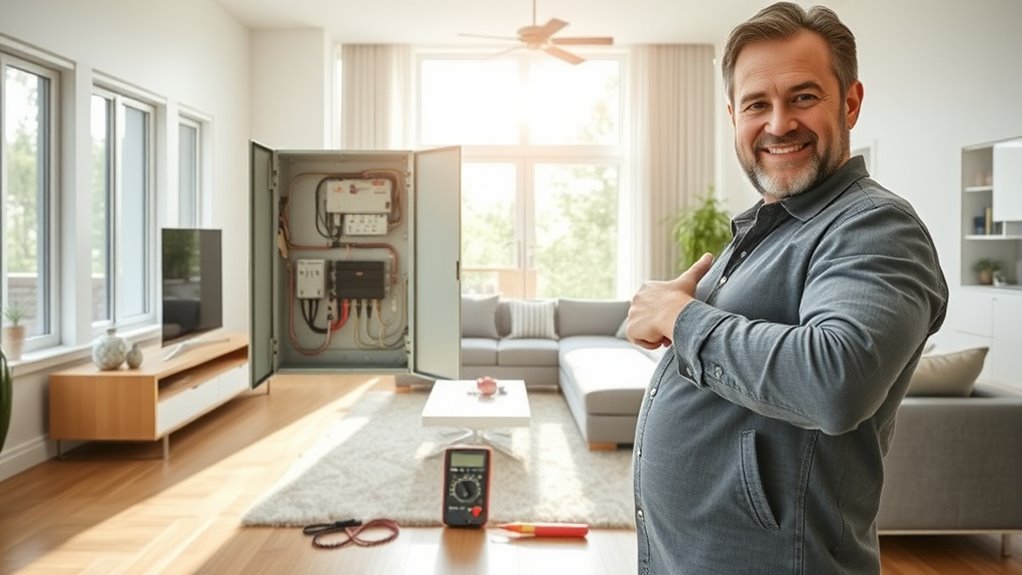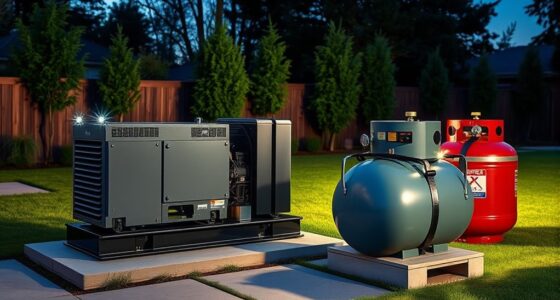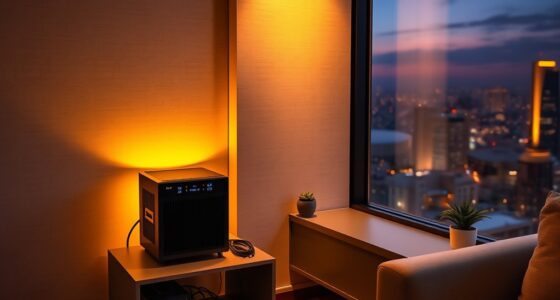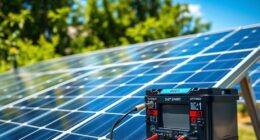Many homeowners believe whole-home surge protection is unnecessary or it prevents all power surges, but that’s not true. While these systems greatly reduce damage risks, they can’t stop every surge, especially during lightning storms. Professional installation guarantees safety and effectiveness, and regular checks help identify faults. If you’re curious about the myths versus facts and want to protect your home smarter, there’s plenty more to discover about what works—and what doesn’t.
Key Takeaways
- Whole-home surge protectors defend entire electrical systems from lightning and voltage spikes, contrary to the myth they are unnecessary.
- Professional installation ensures safety, proper grounding, and compliance; DIY risks include shock, fire, and ineffective protection.
- Regular inspections for visible damage and power inconsistencies help detect surge protector faults early, preventing fire hazards and equipment damage.
- Surge protectors have limits; they reduce but do not eliminate all surges, especially during severe lightning storms or electrical grid issues.
- Maintenance, timely replacement, and proper system checks extend surge protector lifespan and can lower home insurance premiums.
Common Misconceptions About Whole-Home Surge Protection

Many people believe that installing a whole-home surge protector is unnecessary or that it provides limited protection. They often think that lightning strikes or power outages won’t affect their home equipment. However, lightning strikes can cause sudden voltage surges that travel through your wiring, damaging appliances and electronics. Power outages might seem harmless, but the surges that follow when power is restored can be just as damaging. A whole-home surge protector helps shield your entire electrical system from these unexpected spikes, reducing the risk of costly repairs or replacements. It’s a proactive step to safeguard your home’s electronics, even if you believe the threat is minimal. Don’t underestimate the potential damage from lightning or power fluctuations—protect your home properly.
When Is a Whole-Home Surge Protector Necessary?

A whole-home surge protector becomes essential if you live in an area prone to frequent thunderstorms or experience unpredictable power fluctuations. Such conditions increase the risk of power surges that can damage your electrical wiring and appliances. If your home’s electrical wiring is outdated or not properly grounded, a surge protector helps safeguard your system from sudden spikes. Additionally, a surge protector’s lifespan is finite—it can wear out over time, especially after multiple surges. Knowing when to install one is vital, particularly if your home faces frequent electrical disturbances. Installing a whole-home surge protector provides continuous protection and can prevent costly damage caused by unexpected power surges, making it a smart investment for safeguarding your home’s electrical system. Regularly checking for signs of electrical wiring spoilage, such as off-smell or discoloration, helps ensure your system remains protected and functional.
The Cost Differences Between Types of Surge Protectors

The cost of surge protectors varies considerably depending on their type and level of protection. Basic plug-in models tend to be affordable, with pricing options starting around $20 to $50, making them suitable for individual devices. Whole-home surge protectors, which are installed at your main electrical panel, typically cost between $100 and $600, depending on their features and capacity. Keep in mind that installation costs can add to the overall expense, especially if professional wiring is required. Investing in a higher-quality surge protector may have higher upfront costs but can provide better protection and longevity. When comparing options, consider both the initial price and the long-term value, including installation and the level of surge protection offered. Additionally, selecting a professional installation ensures your system is properly configured for maximum safety and effectiveness.
Do Whole-Home Surge Protectors Prevent All Power Surges?
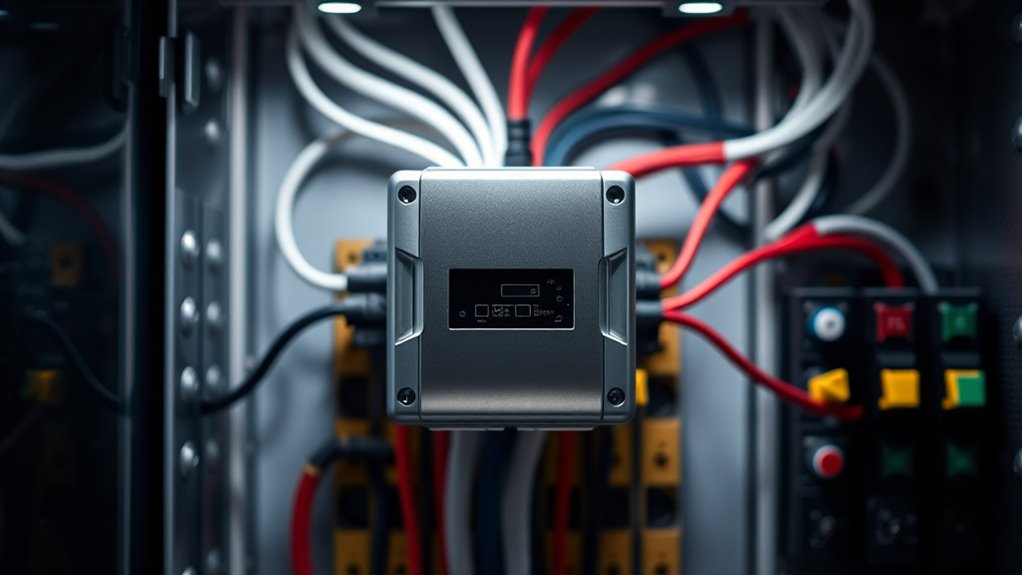
Whole-home surge protectors greatly reduce the risk of damage from power surges, but they don’t prevent all surges. They work by managing voltage regulation and diverting excess energy, but some surges may bypass the system, especially if they are extremely high or rapid. The effectiveness of a surge protector depends on its circuit design, which determines how well it responds to different surge levels. While a high-quality protector can handle most common surges, no device can guarantee complete protection against every electrical event. Lightning strikes or severe grid fluctuations might still cause damage. Consequently, understanding that whole-home surge protectors substantially lower risk, but don’t eliminate it, helps set realistic expectations for safeguarding your home’s electrical system. Resources and Tools can provide additional guidance on selecting the right protection.
The Role of Individual Surge Protectors for Devices

While whole-home surge protectors reduce the risk of electrical damage, they don’t cover every device in your house. That’s where individual surge protectors come in. They provide targeted protection for sensitive electronics like computers, gaming consoles, and home entertainment systems. When choosing an individual surge protector, check device compatibility to ensure it can handle the surge current your devices may encounter. Keep in mind that surge protector lifespan varies; over time, protection capabilities weaken, even if the protector looks fine. Regularly replacing or testing these protectors guarantees your devices stay protected. Using both whole-home and individual surge protectors creates a layered defense, minimizing damage from power surges and extending your equipment’s lifespan. Incorporating specialized dog beds can also help protect your pet’s comfort and health from electrical issues.
Installing Whole-Home Surge Protection: DIY or Professional?

Installing whole-home surge protection isn’t a simple job, and hiring a professional guarantees it’s done safely and correctly. Attempting a DIY install can be risky, especially if you lack electrical experience or proper tools. Consider your skills and the complexity of the system before deciding whether to tackle it yourself or call in an expert. Additionally, understanding the role of surge protectors in safeguarding your home is essential to ensure your system is properly protected.
Professional Installation Necessity
Although some homeowners consider installing surge protection themselves, professional installation guarantees the system is correctly set up and tested for peak performance. You’ll benefit from a proper installation process that guarantees safety and reliability. Here are four reasons to choose professional help:
- Cost comparison: Professionals can prevent costly mistakes that might lead to damage or system failure.
- Expertise: They understand complex wiring and electrical systems, ensuring correct placement.
- Compliance: Professionals follow local codes and manufacturer guidelines, avoiding legal issues.
- Testing and warranty: Proper testing guarantees excellent performance, and many installations include warranties for peace of mind.
- Additionally, proper installation accounts for trust issues with electrical components, ensuring your system remains dependable over time.
Opting for professional installation might cost more upfront but offers long-term savings, safety, and peace of mind.
DIY Risks and Challenges
Attempting to install whole-home surge protection yourself can seem like a cost-saving solution, but it comes with significant risks and challenges. DIY hazards include electrical shock, improper grounding, and damage to your home’s wiring. Installation challenges can be complex, requiring precise knowledge of your electrical system and adherence to local codes. Without proper training, you risk not only ineffective surge protection but also creating fire hazards. Missing critical steps or misconnecting components can lead to costly repairs down the line. Additionally, many surge protectors need to be installed at specific points in your electrical panel, which can be dangerous and difficult to access without professional tools and experience. Ultimately, the risks outweigh any potential savings, making professional installation the safer, more reliable choice.
How to Recognize a Faulty Surge Protector System

You should regularly check your surge protector for visible damage like scorch marks, cracks, or frayed wires. If you notice flickering lights or sudden power drops, your system might be faulty. Recognizing these signs helps prevent potential damage to your devices and keeps your home safe. Additionally, being aware of lifestyle factors such as proper workspace organization can contribute to overall safety and efficiency in managing electrical systems.
Visible Damage Signs
Visible damage is one of the clearest signs that your surge protector system may be faulty. Look for physical indicators such as:
- Burn marks or scorch spots around outlets or wiring, suggesting electrical stress.
- Chipped or melted lighting fixtures, which can result from power surges bypassing protection.
- Frayed or damaged electrical wiring near surge protection devices, increasing fire risk.
- Discoloration or warping on the surge protector itself, indicating overheating or internal failure.
- Regularly inspecting your surge protection system helps ensure it maintains proper electrical safety and functions correctly.
If you notice any of these signs, avoid using affected circuits and have a professional inspect your whole-home surge protection system. Addressing visible damage promptly helps prevent further electrical issues and potential fire hazards.
Inconsistent Power Flow
Signs of visible damage often indicate a surge protector’s failure, but inconsistent power flow can also reveal problems that aren’t immediately obvious. If you notice frequent power fluctuation or voltage inconsistency, it might mean your surge protector isn’t functioning properly. These issues can cause your devices to turn on and off unexpectedly or operate erratically. A faulty surge protector may fail to regulate voltage spikes effectively, leading to unstable electrical current in your home. Pay attention to sudden surges or dips in power, especially during storms or electrical activity. Recognizing these signs early can prevent damage to your appliances and highlight the need for a system check or replacement. Inconsistent power flow is a clear indicator that your surge protection may be compromised. Additionally, automation’s role in business intelligence can help monitor electrical systems in smart homes to detect such irregularities more efficiently.
Myths About Maintenance and Replacement of Surge Protectors
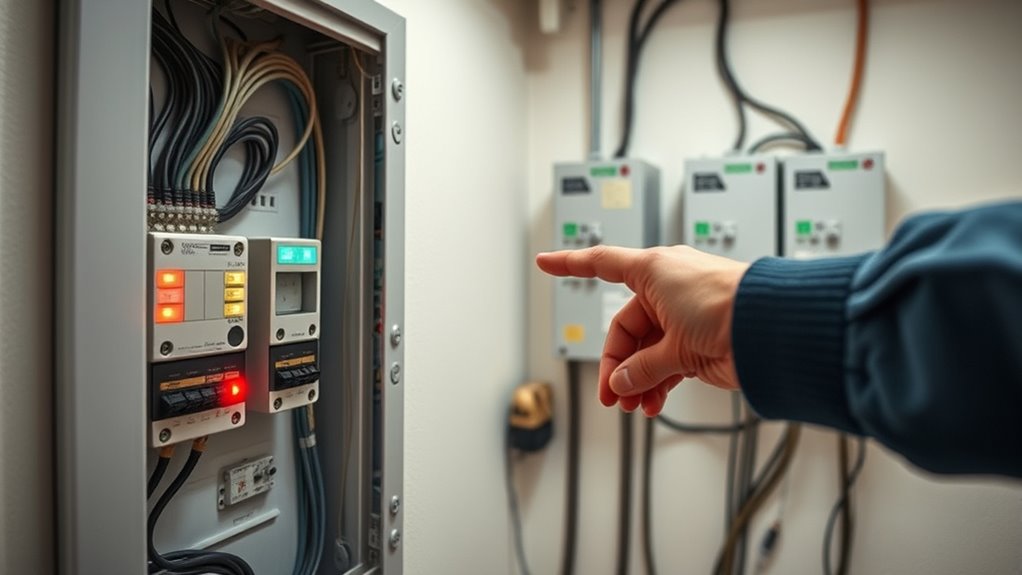
Many people believe that surge protectors require little to no maintenance once installed, but this is a common misconception. Maintenance myths can lead you to neglect crucial upkeep, risking surge protection failure. In reality, understanding replacement facts is essential for safety and effectiveness. Regular inspections are necessary to ensure the device isn’t damaged or worn out. Surge protectors don’t last forever; they need replacement after several years or after a significant surge event. Indicators like blinking lights or damage signs signal the time for replacement. Dirty or dusty units should be cleaned to maintain peak performance. Additionally, staying informed about HVAC system advancements can help optimize your home’s overall electrical safety.
The Impact of Surge Protection on Home Insurance and Safety
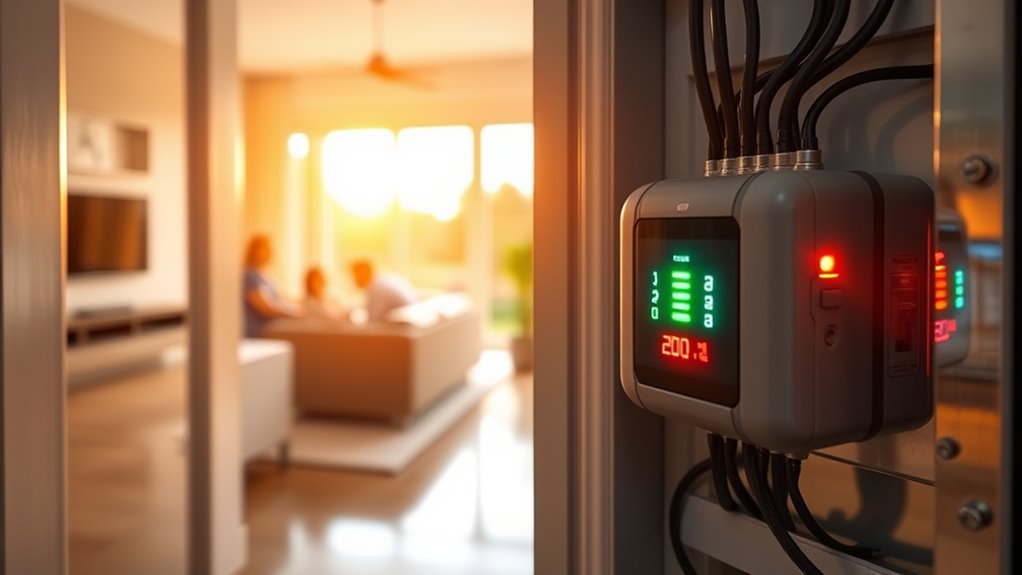
Installing surge protection can substantially influence your home insurance policy by potentially lowering premiums and reducing the risk of costly damages. Many insurers recognize the safety benefits of whole-home surge protection, which can prevent electrical fires and damage to appliances. As a result, some providers offer insurance benefits like discounts or improved coverage for homes with proper surge protection in place. Beyond financial incentives, surge protection enhances safety considerations by minimizing the risk of electrical surges causing fires, equipment failure, or injuries. By installing a all-encompassing surge protection system, you’re not only safeguarding your appliances but also demonstrating proactive safety measures. This proactive approach can lead to better insurance terms and peace of mind, knowing your home is less vulnerable to surge-related hazards.
Frequently Asked Questions
Can Whole-Home Surge Protectors Interfere With Home Electrical Systems?
Whole-home surge protectors generally don’t interfere with your home’s electrical systems if installed correctly. However, some models can cause electrical noise or circuit interference, leading to minor disruptions in sensitive electronics. To avoid this, choose high-quality protectors and have a professional install them. Proper installation minimizes the risk of electrical noise, ensuring your system remains stable and protected without causing issues or interference.
Are There Specific Brands Recommended for Reliable Surge Protection?
You should look into trusted brands like Square D, Eaton, or Siemens for reliable surge protection. Studies show that about 80% of homeowners prefer these brands for their durability and effectiveness. When comparing products, check for UL listing and warranties. Doing thorough product comparisons helps you choose a surge protector that fits your needs, ensuring your home’s electrical system stays safe without sacrificing performance.
How Long Do Whole-Home Surge Protectors Typically Last?
Your surge protector lifespan usually ranges from 5 to 10 years, but it depends on surge frequency and power levels. You should watch for replacement indicators like frequent tripping or diminished performance. Regularly checking your surge protector guarantees it remains effective, and replacing it when you notice these signs helps protect your home electronics from unexpected surges. Don’t wait too long—timely replacement keeps your system safe and reliable.
Do Surge Protectors Affect the Energy Efficiency of My Home?
Surge protectors don’t substantially affect your home’s energy consumption or device performance. They mainly act as a safeguard against power surges, so your devices run smoothly without interruption. Modern surge protectors are designed to be energy-efficient, meaning they don’t draw extra power when not protecting against surges. You can confidently use whole-home surge protection without worrying about increased energy bills or compromised device performance.
What Are Signs That My Surge Protection System Needs an Upgrade?
You should upgrade your surge protection system if you notice frequent power surges or if your devices experience electrical damage despite being protected. Signs include tripped circuit breakers, burnt outlets, or damaged electronics. Over time, surge protectors wear out and lose effectiveness, leaving your home vulnerable. Upgrading guarantees your system can handle future electrical surges and prevents potential damage to your appliances and electronics.
Conclusion
Don’t let myths about surge protection leave your home vulnerable. By understanding when and why to use a whole-home surge protector, you’re guarding your entire world from power surges like a superhero with an invincible shield. Skip the confusion, do it right, and keep your devices safe. Remember, a faulty system can be a wolf in sheep’s clothing—so stay vigilant and protect your castle from electrical chaos. Your home’s safety depends on it!
